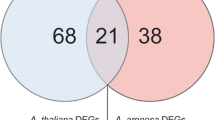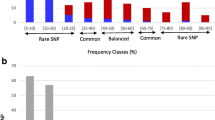Abstract
The Asr gene family (named after abscicic acid [ABA], stress, ripening), exclusively present in plant genomes, is involved in transcriptional regulation. Its members are up-regulated in roots and leaves of water- or salt-stressed plants. In previous work, evidence of adaptive evolution (as inferred from synonymous and nonsynonymous divergence rates) has been reported for Asr2 in Solanum chilense and S. arcanum, two species dwelling in habitats with different precipitation regimes. In this paper we investigate patterns of intraspecific nucleotide variation in Asr2 and the unlinked locus CT114 in S. chilense and S. arcanum. The extent of nucleotide diversity in Asr2 differed between species in more than one order of magnitude. In both species we detected evidence of non-neutral evolution, which may be ascribed to different selective regimes, potentially associated to unique climatic features, or, alternatively, to demographic events. The results are discussed in the light of demographic and selective hypotheses.





Similar content being viewed by others
References
Aguadé M (2001) Nucleotide sequence variation at two genes of the phenylpropanoid pathway, the FAH1 and F3H genes, in Arabidopsis thaliana. Mol Biol Evol 18:1–9
Ardell DH (2004) SCANMS: adjusting for multiple comparisons in sliding window neutrality tests. Bioinformatics 20:1986–1988. doi:10.1093/bioinformatics/bth187
Arunyawat U, Stephan W, Städler T (2007) Using multilocus sequence data to assess population structure, natural selection, and linkage disequilibrium in wild tomatoes. Mol Biol Evol 24:2310–2322. doi:10.1093/molbev/msm162
Baudry E, Depaulis F (2003) Effect of misoriented sites on neutrality tests with outgroup. Genetics 165:1619–1622
Bermudez-Moretti M, Maskin L, Gudesblat G, Correa-García S, Iusem ND (2006) Asr1, a stress-induced tomato protein, protects yeast from osmotic stress. Physiol Plant 127:111–118. doi:10.1111/j.1399-3054.2006.00664.x
Bradley RD, Hillis DM (1997) Recombinant DNA sequences generated by PCR amplification. Mol Biol Evol 14:592–593
Cakir B, Agasse A, Gaillard C, Saumonneau A, Delrot S, Atanassova R (2003) A grape ASR protein involved in sugar and abscisic acid signaling. Plant Cell 15:2165–2180. doi:10.1105/tpc.013854
Clement M, Posada D, Crandall KA (2000) TCS: a computer program to estimate gene genealogies. Mol Ecol 9:1657–1659. doi:10.1046/j.1365-294x.2000.01020.x
Crandall KA, Templeton AR (1999) Statistical methods for detecting recombination. In: Crandall KA (ed) The evolution of HIV. The Johns Hopkins University Press, pp 153–176
Fay JC, Wu CI (2000) Hitchhiking under positive Darwinian selection. Genetics 155:1405–1413
Filatov DA, Charlesworth D (1999) DNA polymorphism, haplotype structure and balancing selection in the Leavenworthia PgiC locus. Genetics 153:1423–1434
Frankel N, Hasson E, Iusem ND, Rossi MS (2003) Adaptive evolution of water stress-induced gene Asr2 in Lycopersicon species dwelling in arid habitats. Mol Biol Evol 20:1955–1962. doi:10.1093/molbev/msg214
Fu Y-X (1997) Statistical tests of neutrality of mutations against population growth, hitchhiking and background selection. Genetics 147:915–925
Fu Y-X, Li W-H (1993) Statistical tests of neutrality of mutations. Genetics 133:693–709
Ganal MW, Czihal R, Hannappel U, Kloos DU, Polley A, Ling HQ (1998) Sequencing of cDNA clones from the genetic map of tomato (Lycopersicon esculentum). Genome Res 8:842–847
Hanfstingl U, Berry A, Kellogg EA, Costa JT, Rudiger W, Ausubel FM (1994) Haplotypic divergence coupled with lack of diversity at the Arabidopsis thaliana alcohol dehydrogenase locus: roles for both balancing and directional selection? Genetics 138:811–828
Hoekstra FA, Golovina EA, Buitink J (2001) Mechanisms of plant desiccation tolerance. Trends Plant Sci 6:431–438. doi:10.1016/S1360-1385(01)02052-0
Hudson RR (1990) Gene genealogies and the coalescent process. Oxf Surv Evol Biol 7:1–44
Hudson RR (2002) Generating samples under a Wright-Fisher neutral model of genetic variation. Bioinformatics 18:337–338. doi:10.1093/bioinformatics/18.2.337
Hudson RR, Kaplan NL (1985) Statistical properties of the number of recombination events in the history of a sample of DNA sequences. Genetics 111:147–164
Hudson RR, Boos D, Kaplan NL (1992) A statistical test for detecting geographic subdivision. Mol Biol Evol 9:138–151
Iusem ND, Bartholomew DM, Hitz WD, Scolnik PA (1993) Tomato transcript induced in water stress and ripening. Plant Physiol 102:1353–1354. doi:10.1104/pp. 102.4.1353
Jeanneau M, Gerentes D, Foueillassar X, Zivy M, Vidal J, Toppan A et al (2002) Improvement of drought tolerance in maize: towards the functional validation of the Zm-Asr1 gene and increase of water use efficiency by over-expressing C4-PEPC. Biochimie 84:1127–1135. doi:10.1016/S0300-9084(02)00024-X
Kalifa Y, Gilad A, Konrad Z, Zaccai M, Scolnik PA, Bar-Zvi D (2004a) The water- and salt-stress regulated Asr1 gene encodes a zinc-dependent DNA-binding protein. Biochem J 381:373–378. doi:10.1042/BJ20031800
Kalifa Y, Perlson E, Gilad A, Konrad Z, Scolnik PA, Bar-Zvi D (2004b) Over-expression of the water and salt stress-regulated Asr1 gene confers an increased salt tolerance. Plant Cell Environ 27:1459–1468. doi:10.1111/j.1365-3040.2004.01251.x
Kane NC, Rieseberg LH (2007) Selective sweeps reveal candidate genes for adaptation to drought and salt tolerance in common sunflower, Helianthus annuus. Genetics 175:1823–1834. doi:10.1534/genetics.106.067728
Kimura M (1983) The neutral theory of molecular evolution. Cambridge University Press, Cambridge, UK
Maskin L, Gudesblat GE, Moreno JE, Carrari FO, Frankel N, Sambade A et al (2001) Differential expression of the members of the Asr gene family in tomato (Lycopersicon esculentum). Plant Sci 161:739–746. doi:10.1016/S0168-9452(01)00464-2
Maynard Smith J, Haigh J (1974) The hitch-hiking effect of a favourable gene. Genet Res 23:23–35
Mustonen V, Lässig M (2007) Adaptations to fluctuating selection in Drosophila. Proc Natl Acad Sci USA 104:2277–2282. doi:10.1073/pnas.0607105104
Peralta IE, Spooner DM (2001) Granule-bound starch synthase (GBSSI) gene phylogeny of wild tomatoes. Am J Bot 88:1888–1902. doi:10.2307/3558365
Peters S, Mundree SG, Thomson JA, Farrant JM, Keller F (2007) Protection mechanisms in the resurrection plant Xerophyta viscosa (Baker): both sucrose and raffinose family oligosaccharides (RFOs) accumulate in leaves in response to water deficit. J Exp Bot 58:1947–1956. doi:10.1093/jxb/erm056
Qiu YL, Palmer JD (1999) Phylogeny of early land plants: insights from genes and genomes. Trends Plant Sci 4:26–30. doi:10.1016/S1360-1385(98)01361-2
Roselius K, Stephan W, Städler T (2005) The relationship of nucleotide polymorphism, recombination rate and selection in wild tomato species. Genetics 171:753–763. doi:10.1534/genetics.105.043877
Rossi MM, Iusem ND (1994) Tomato genomic clone homologous to a gene encoding an ABA-induced protein. Plant Physiol 104:1073–1074. doi:10.1104/pp. 104.3.1073
Rossi MM, Lijavetzky D, Bernacchi D, Hopp HE, Iusem ND (1996) Asr genes belong to a tomato gene family of at least three closely linked loci located to chromosome 4. Mol Gen Genet 252:489–492
Rozas J, Sánchez-Del Barrio JC, Messeguer X, Rozas R (2003) DnaSP, DNA polymorphism analyses by the coalescent and other methods. Bioinformatics 19:2496–2497. doi:10.1093/bioinformatics/btg359
Städler T, Roselius K, Stephan W (2005) Genealogical footprints of speciation processes in wild tomatoes: demography and evidence for historical gene flow. Evol Int J Org Evol 59:1268–1279
Tajima F (1989) Statistical method for testing the neutral mutation hypothesis. Genetics 123:585–595
Templeton AR, Crandall KA, Sing CF (1992) A cladistic analysis of phenotypic associations with haplotypes inferred from restriction endonuclease mapping and DNA sequence data. III. Cladogram estimation. Genetics 132:619–633
Tunnacliffe A, Wise MJ (2007) The continuing conundrum of the LEA proteins. Naturwissenschaften 94:791–812. doi:10.1007/s00114-007-0254-y
Urao T, Yakubov B, Satoh R, Yamaguchi-Shinozaki K, Seki M, Hirayama T et al (1999) A transmembrane hybrid-type histidine kinase in Arabidopsis functions as an osmosensor. Plant Cell 11:1743–1754
Wall JD, Andolfatto P, Przeworski M (2002) Testing models of selection and demography in Drosophila simulans. Genetics 162:203–216
Watterson GA (1975) On the number of segregating sites in genetical models without recombination. Theor Popul Biol 7:188–193
Yang CY, Chen YC, Jauh GY, Wang CS (2005) A Lily ASR protein involves abscisic acid signaling and confers drought and salt resistance in Arabidopsis. Plant Physiol 139:836–846
Acknowledgements
We thank the Tomato Genetics Resource Center (University of California, Davis, USA) for providing the seeds of the tomato wild populations and Gustavo Gudesblat for his valuable help with the experimental work in the laboratory. We also wish to thank Romina Piccinali and David Ardell for their help with technical issues of software usage, and two anonymous reviewers for their constructive comments and criticisms on a previous version of this manuscript. This work was supported by grants from Universidad de Buenos Aires (UBA), Agencia Nacional de Promoción Científica y Tecnológica (ANPCyT) and Consejo Nacional de Investigaciones Científicas y Tecnológicas (CONICET), Argentina. M.G. held a fellowship from UBA. N.F. held a fellowship from CONICET. N.D.I. and E.H. are members of the Carrera del Investigador Científico, CONICET, Argentina.
Author information
Authors and Affiliations
Corresponding author
Rights and permissions
About this article
Cite this article
Giombini, M.I., Frankel, N., Iusem, N.D. et al. Nucleotide polymorphism in the drought responsive gene Asr2 in wild populations of tomato. Genetica 136, 13–25 (2009). https://doi.org/10.1007/s10709-008-9295-1
Received:
Accepted:
Published:
Issue Date:
DOI: https://doi.org/10.1007/s10709-008-9295-1




